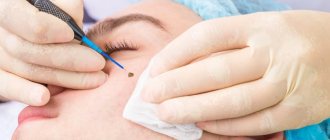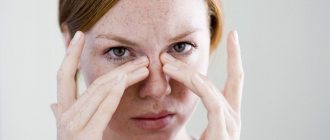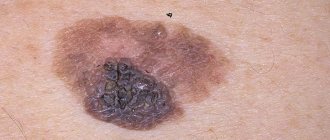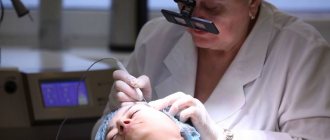Every Tuesday, AiF Health explains what signs may indicate that it’s time for you to see a doctor. This week we tell you why moles are dangerous, how to notice the first signs of a mole degenerating into a malignant skin tumor, and which specialist to turn to for help.
Many people do not pay attention to this “rebirth” and think that their body is still just a harmless spot. Meanwhile, early diagnosis helps defeat the disease.
Is it time to sound the alarm?
Moles, or, in scientific terms, nevi, are present on the body of every person. It is believed that the bulk of them, up to 90%, appear by the age of 25. But they can also arise later - under the influence of various events. For example, a typical phenomenon is when they literally break out during pregnancy. Sometimes moles, on the contrary, disappear over time. They can be yellow, brown, black. This is all within normal limits and there is nothing to worry about.
But it happens that a mole begins to grow unevenly or changes color, its surface becomes “polished” or it begins to bleed - that is, changes occur in it. Another option is the appearance of a new mole of an unusual appearance. It is precisely such incomprehensible neoplasms that require close attention.
Classification
There are 2 main groups of moles:
- 1. Vascular, or angiomas. They are formed during the rapid growth of subcutaneous capillaries with a change in the structure of their walls.
- 2. Pigmented, or nevi. Occurs when an excess amount of melanin appears in cells.
They are also divided according to their depth into:
● epidermal (on the top layer of skin);
● intradermal (located slightly deeper than the previous ones);
● borderline (develop between the epidermis and dermis).
When the sun is the enemy
Probably everyone already knows that a chocolate tan has little to do with health. Ultraviolet radiation causes DNA damage and is the main cause of malignant skin tumors. The more time a person spends exposing his body to the rays, the higher the likelihood of unpleasant consequences. The activity of the sun is also important. It is no coincidence that dermatologists strongly advise not to be on the beach between 11 and 16 hours of the day, when it is most aggressive.
By the way, many scientists associate the risk of developing melanoma with the fact that in childhood and adolescence a person often received sunburn. They cause changes in melanocytes, the pigment cells of the skin, which over time lead to malignant conditions. This also explains the fact that in almost 50% of cases, melanoma develops on the legs - they are always open in children in the summer and are most exposed to solar radiation.
Lately, there has been more and more talk about the dangers of “artificial sun” – solariums. According to some reports, one session here (which is usually 5-10 minutes) is equal to a whole day on the beach! Some European countries (Germany, France and Austria) and the state of California (USA) have even banned the use of solariums for children under 18 years of age.
Of course, the sun is a source of vitamin D and a remedy for depression, but in large quantities it is the real enemy. Otherwise, the World Health Organization would not recognize ultraviolet radiation as a carcinogen on a par with arsenic, smoking and asbestos.
Mole on the body: causes of occurrence
The main factors that contribute to the appearance of moles:
- ● Heredity.
- ● Ultraviolet. Prolonged exposure to the sun, especially at midday, stimulates the production of melanin, and, accordingly, moles.
- ● Hormonal background. A sharp change in hormone production can lead to both the formation and disappearance of nevi. The main periods of life when the risk is high: menopause, pregnancy, adolescence.
- ● Radiation, viruses and injuries. Mechanical stress on the skin can also cause moles.
Where to run?
If you notice an unusual mole on your body, be sure to go to a dermato-oncologist. If this doctor is not available, you can consult a dermatologist, surgeon or oncologist. An experienced specialist can visually determine the nature of the nevus. A special device called a dermatoscope helps him with this. Essentially, this is a powerful magnifying glass; by examining a mole through it, the doctor can notice the smallest details that are simply impossible to see with the naked eye. If there is doubt about the diagnosis, the doctor will conduct a histological examination to determine the characteristic signs of benign, premalignant and malignant neoplasms.
By the way, if you want to remove a mole for aesthetic reasons, then the decision should also be made by a dermato-oncologist after dermatoscopy, which allows you to choose the optimal method, determine the boundaries and depth of removal.
Even if degeneration into melanoma has not occurred, for medical reasons those moles that are subject to constant friction, pressure, and injury are removed. And also those that are in the groin area and under the arms, under the chest, on the belt, and in men - on the face at the shaving site.
If a mole that has degenerated into melanoma is removed at an early stage, the probability of complete recovery reaches 95%; if time is lost, it is only 20%.
What to do if you damage a mole?
Every person has moles on the face and body, and many probably know that damage to these tumors can lead to the development of malignant tumors. This fact is not just a “horror story” from the field of medicine, but a clinically proven fact. Therefore, if a mole is damaged, it is very important to act correctly to eliminate a threat to health. Sometimes moles are mistakenly considered to be neoplasms that are viral or other in nature. True moles or nevi are slightly raised areas of dark brown pigmented skin. It is they, if damaged, that can cause the development of a dangerous disease - skin cancer or melanoma, read more about it in the article “Skin cancer: melanoma.” This disease very often progresses without being noticed, and is practically untreatable in its later stages.
Signs of the development of melanoma after damage to a mole
Suspicion of the development of skin cancer caused by damage to a nevus should cause the following symptoms:
- pain in the injured area that does not go away for a long time;
- itching and development of the inflammatory process, more about this is written in the article “A mole itches and peels. What to do?";
- hair loss in the area of the mole;
- change in skin color around the nevus;
- formation of nodules;
- the growth of a mole, read about why this happens in the article “Why does a mole grow? What to do?".
All these signs indicate that the injured mole has begun to develop into melanoma.
In this case, you must consult a doctor and undergo appropriate examination. Consequences of damage to a mole-angioma
This type of skin neoplasm appears due to impaired permeability and decreased tone of the walls of blood vessels and has a dark cherry or bluish color. An angioma can be oval in shape and slightly rise above the level of healthy skin, or it can be a large birthmark. Since the tissues in the area of this neoplasm are saturated with blood vessels and capillaries, any damage entails heavy bleeding. After injury, angiomas heal quickly without any negative consequences, since these neoplasms are benign in nature and do not provoke the development of oncological processes.
Consequences of damage to a mole-papilloma
Papillomas are infectious and viral in nature and are not essentially moles. Since these new growths practically do not differ in color from healthy skin, but clearly rise above it, they are very easy to damage or tear off. Injury to papilloma is accompanied by painful sensations, since these neoplasms cover the nerve endings in the skin, but bleeding is rarely intense. Damage to the papilloma will not lead to the development of skin cancer, but it can lead to the spread of infection to healthy skin and the growth of tumors.
Sign up for a free consultation right now, or leave a request and we will contact you and answer all your questions
Leave a request for a call Sign up
Regardless of which mole you damaged or tore off, you need to carry out a number of manipulations:
1. If there is bleeding, stop the bleeding by applying a compression bandage.
2. Disinfect the injured area with alcohol, hydrogen peroxide or other antiseptic agent.
3. Consult a doctor to examine the damaged tumor and clarify the nature of its origin. If the mole is completely torn off, it is advisable to save a piece of tissue and transfer it to the laboratory for research as soon as possible.
If the neoplasm is not cancerous and its presence on the skin causes cosmetic or physical discomfort, doctors may recommend complete removal of the mole. But under no circumstances should you make this decision on your own, much less try to get rid of the mole on your own. The procedure must take place under antiseptic conditions and be carried out by a qualified specialist - only in this case can it be guaranteed that the removal of the tumor will take place without any negative consequences. Today, the most common and effective method of performing this procedure is laser removal of moles.
In general, the idea that damage to a mole will certainly lead to the development of cancer is greatly exaggerated. Not every skin tumor is malignant or can turn into melanoma under the influence of external factors. However, if the integrity of this area is violated, you should be vigilant and seek medical advice. If melanoma is suspected, you will be recommended a diagnostic examination that will help exclude or confirm the presence of an oncological process and take appropriate measures in a timely manner.
Removal of tumors at Lazmed Clinic
Which doctor should I contact to remove a mole?
Laser mole removal is performed by a doctor who has been trained in the use of laser technology. Depending on the area of localization of the mole and its characteristics, the specialists to whom patients turn may be the following:
- dermatologist when placing the element on the torso, limbs, scalp;
- doctor - dermatocosmetologist if the formation is on the face, including other localizations;
- an oncologist if there is a large mole, or one that has recently increased in size or changed color;
- gynecologist when a tumor is located in the intimate area.
Skin melanoma and its dangers
Let's take a closer look at what skin melanoma is. This is a cancer that develops from pigment cells - melanocytes. Due to a violation of the DNA structure, their uncontrolled malignant growth begins. Amelanotic melanoma is a particularly dangerous form of the disease with an aggressive course. Occurs in 1.8-8.1% of cases of such skin cancer, requiring treatment to begin as early as possible.
As one of the types of malignant neoplasms of the skin, melanoma accounts for 3% of all types of cancer, and in terms of the average annual increase in cases it is ahead of other cancers (about 3.9% per year in Russia). Over the past 40 years, the number of patients with this diagnosis has increased 15 times, but at the same time there has been an increase in overall 5-year survival. This is explained by the early diagnosis of melanoma at a stage when the tumor has not had time to grow in depth, improvement of surgical treatment methods and antitumor therapy.
The prognosis for cure is most favorable if cancer is detected at an early stage. The survival rate is 90-95%. At an early stage, the tumor can be removed, and then the condition of the skin can be monitored so that in case of relapse, it can be detected in time and measures taken.
Why you shouldn't sunbathe after mole removal
In the previous answer we partially answered the question. In the area of the epidermis that is not formed after laser removal, the risk of neoplasia (improper cell division) increases with the risk of developing cancer cells in the future. The second reason is the risk of age spots. The mechanism is almost the same. The weak, immature epidermis, trying to protect itself under the influence of sunlight, begins to actively produce the pigment melanin. This process goes faster than in nearby undamaged skin. Therefore, the intensity of skin coloring under the rays of the sun is different. A hyperpigmented area appears at the site where the mole was removed by laser.
How long should you not sunbathe after mole removal?
Within 14 days after laser removal of a mole, the epidermis forms under the scab. After the crust has fallen off, thin newly formed skin is visible at the removal site. The epidermis (surface layer) has not yet had time to accumulate melanin in the cells, a substance that protects our body from ultraviolet radiation. This means that this place becomes vulnerable and it is in this zone that processes of improper cell division can begin. Therefore, after laser removal of not only moles, but also other neoplasms or blood vessels on the skin, direct exposure to sunlight on this area should be avoided for at least 2 months. Or, while tanning, cover the areas with a fabric that reliably protects the area from the sun (cotton shirt and trousers).
5. How many days does it take for a wound to heal after a mole is removed?
After removal, a dry crust remains on the skin. This is coagulated tissue. Underneath, healing and restoration of the skin begins to take place. After 7-10 days, this crust falls off on its own. Under no circumstances should you tear it off prematurely. The primary formed scar after the scab has fallen off is still different from the surrounding tissue. Regeneration processes continue in it and complete restoration of the structure ends by the 20th day. The area may still differ in color from the surrounding tissue, since the pigment accumulated in the cells is not equally distributed. But after a month it will be impossible to distinguish the place where the removal took place.











